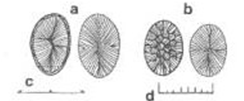HABs taxon details
Prymnesium faveolatum Fresnel, 2001
246601 (urn:lsid:marinespecies.org:taxname:246601)
accepted
Species
marine
Fresnel J., Probert I. & Billard C. 2001. Prymnesium faveolatum sp. nov. (Prymnesiophyceae), a new toxic species from the Mediterranean Sea. Vie et Milieu 51: 89-97. [details]
Type locality contained in Roquebrune-Cap-Martin
type locality contained in Roquebrune-Cap-Martin [details]
Distribution P. faveolatum is presently known from France only.
Harmful effect Toxic to Artemia and therefore probably producer of the same toxin as several other species of Prymnesium.
Identification Safe identification requires electron microscopy. Prymnesium foveolatum may be identified by the structure of the two types...
Distribution P. faveolatum is presently known from France only. [details]
Harmful effect Toxic to Artemia and therefore probably producer of the same toxin as several other species of Prymnesium.
Harmful effect Toxic to Artemia and therefore probably producer of the same toxin as several other species of Prymnesium. [details]
Identification Safe identification requires electron microscopy. Prymnesium foveolatum may be identified by the structure of the two types...
Identification Safe identification requires electron microscopy. Prymnesium foveolatum may be identified by the structure of the two types of organic scales on the cell, both of which are species diagnostic. Scales of the inner layers have radiating lines and a central, variously-shaped X-like structure. The outer scales possess radiating lines covered on the dorsal side by an alveolate pattern that extends to the scale rim. The species is also characterized by the lowest haptonema/flagella ratio reported in Prymnesium>/i> c. (0.15), flagella measuring 14-16 µm in length and the haptonema 2-2.3 µm [details]
Guiry, M.D. & Guiry, G.M. (2024). AlgaeBase. World-wide electronic publication, National University of Ireland, Galway (taxonomic information republished from AlgaeBase with permission of M.D. Guiry). Prymnesium faveolatum Fresnel, 2001. Accessed through: Lundholm, N.; Churro, C.; Escalera, L.; Fraga, S.; Hoppenrath, M.; Iwataki, M.; Larsen, J.; Mertens, K.; Moestrup, Ø.; Murray, S.; Tillmann, U.; Zingone, A. (Eds) (2009 onwards) IOC-UNESCO Taxonomic Reference List of Harmful Micro Algae at: https://www.marinespecies.org/hab/aphia.php?p=taxdetails&id=246601 on 2024-11-12
Lundholm, N.; Churro, C.; Escalera, L.; Fraga, S.; Hoppenrath, M.; Iwataki, M.; Larsen, J.; Mertens, K.; Moestrup, Ø.; Murray, S.; Tillmann, U.; Zingone, A. (Eds) (2009 onwards). IOC-UNESCO Taxonomic Reference List of Harmful Micro Algae. Prymnesium faveolatum Fresnel, 2001. Accessed at: https://www.marinespecies.org/hab/aphia.php?p=taxdetails&id=246601 on 2024-11-12
Date
action
by
original description
Fresnel J., Probert I. & Billard C. 2001. Prymnesium faveolatum sp. nov. (Prymnesiophyceae), a new toxic species from the Mediterranean Sea. Vie et Milieu 51: 89-97. [details]
basis of record Guiry, M.D. & Guiry, G.M. (2024). AlgaeBase. <em>World-wide electronic publication, National University of Ireland, Galway.</em> searched on YYYY-MM-DD., available online at http://www.algaebase.org [details]
additional source Moestrup, Ø., Akselman, R., Cronberg, G., Elbraechter, M., Fraga, S., Halim, Y., Hansen, G., Hoppenrath, M., Larsen, J., Lundholm, N., Nguyen, L. N., Zingone, A. (Eds) (2009 onwards). IOC-UNESCO Taxonomic Reference List of Harmful Micro Algae., available online at http://www.marinespecies.org/HAB [details]
basis of record Guiry, M.D. & Guiry, G.M. (2024). AlgaeBase. <em>World-wide electronic publication, National University of Ireland, Galway.</em> searched on YYYY-MM-DD., available online at http://www.algaebase.org [details]
additional source Moestrup, Ø., Akselman, R., Cronberg, G., Elbraechter, M., Fraga, S., Halim, Y., Hansen, G., Hoppenrath, M., Larsen, J., Lundholm, N., Nguyen, L. N., Zingone, A. (Eds) (2009 onwards). IOC-UNESCO Taxonomic Reference List of Harmful Micro Algae., available online at http://www.marinespecies.org/HAB [details]
 Present
Present  Inaccurate
Inaccurate  Introduced: alien
Introduced: alien  Containing type locality
Containing type locality
From regional or thematic species database
Description Cells oblong-very elongated. Flagella subequal, haptonema much shorter. Cells are covered with two types of elliptic, plare-like scales. Scales of the inner layers have radiating lines and a central variously-shaped X-like structure. The outer scales possess radiating lines covered on the dorsal side by an alveolate pattern.extending to the scale rim. [details]Distribution P. faveolatum is presently known from France only. [details]
Harmful effect Toxic to Artemia and therefore probably producer of the same toxin as several other species of Prymnesium. [details]
Identification Safe identification requires electron microscopy. Prymnesium foveolatum may be identified by the structure of the two types of organic scales on the cell, both of which are species diagnostic. Scales of the inner layers have radiating lines and a central, variously-shaped X-like structure. The outer scales possess radiating lines covered on the dorsal side by an alveolate pattern that extends to the scale rim. The species is also characterized by the lowest haptonema/flagella ratio reported in Prymnesium>/i> c. (0.15), flagella measuring 14-16 µm in length and the haptonema 2-2.3 µm [details]


